Dubai's First Building: A Journey Through Architecture
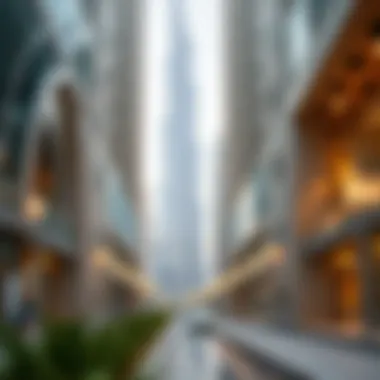
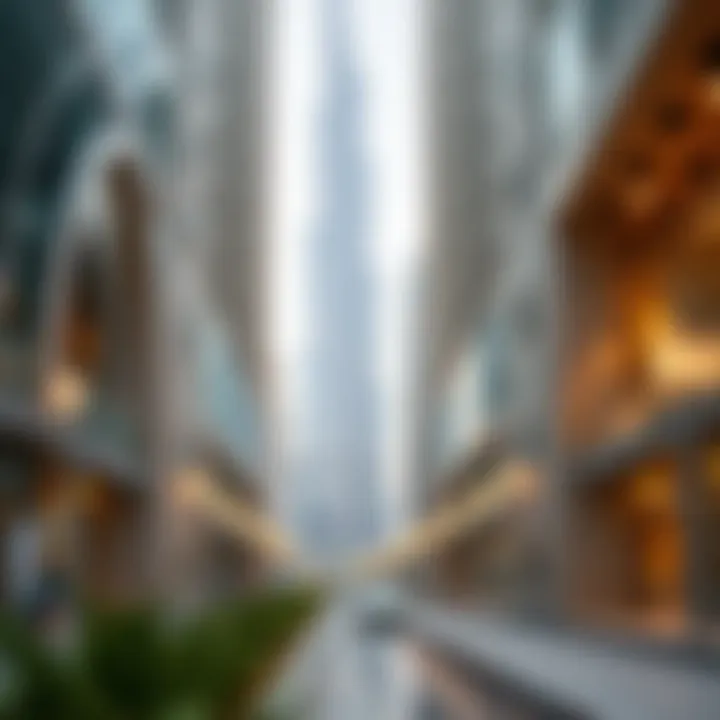
Intro
Dubai, a city synonymous with innovation and grandeur, has roots that dig deep into its architectural heritage. The significance of Dubai's first building may not just be historical; it stands as a testament to the city’s ambitious transformation from a humble fishing village to a global metropolis. This introductory segment sets the stage for uncovering the story behind this pivotal structure, its design nuances, and its socio-cultural implications on Dubai's evolving urban landscape.
Understanding the first building is akin to peeling back the layers of an onion. Each layer represents the craftsmanship and vision that paved the way for the present-day skyline, a mix of modern designs and traditional touches. In this piece, we aim to navigate through the compelling narrative of the first building, exploring its architectural choices alongside its influence on the surrounding neighborhoods and the real estate market that has surged since its inception.
As we take a closer look, prepare to grasp not just the factual underpinnings but also the emotional pulse of a city that thrives on its history while ambitiously racing towards the future.
Intro to Dubai's First Building
Exploring the roots of Dubai's architectural marvels leads us to its very first building, a testament not just to the city's journey but also to its cultural evolution. This section serves as an essential gateway to understanding the significance of this historical landmark. The building acts as a cornerstone for Dubai, illustrating its transformation from humble beginnings into a global metropolis brimming with shimmering skyscrapers and luxurious amenities.
In tracing the footsteps of this structure, we delve into a world where sand dunes once reigned, and palm fronds were the primary materials used in construction. As we explore its inception, we will unpack the cultural backdrop that gave rise to this architectural dream and how it has woven itself into the very fabric of Dubai's identity.
Historical Context
To appreciate Dubai's first building, it's crucial to situate it within the broader historical framework of the region. The 19th century marked pivotal changes for the Arabian Gulf. At that time, Dubai was not much more than a small fishing village protruding into the waters of the Gulf, yet it was simmering with potential. Established trade routes soon turned Dubai into a trading hub, as merchants began to recognize not just its strategic location, but also its opportunity for growth.
In 1896, the first building took shape, marking the commencement of Dubai's architectural narrative. Constructed over a period where other Gulf states were rapidly modernizing their infrastructures, this building stood as both a practical structure and a bold statement of ambition. It materialized aspirations that’d entice investors and families alike, shaping future developments that would follow.
Importance to Dubai's Development
The birth of this building was not merely an architectural milestone but a catalyst that ignited Dubai's urban development. Its significance is multifaceted:
- Economic Growth: The first building attracted potential investors, paving the way for further economic opportunities. The sense of permanence it provided showcased the city’s potential in business.
- Cultural Identity: Beyond bricks and mortar, the building encapsulated the traditional values of the Emirati people, serving as a physical representation of their heritage in a rapidly modernizing world.
- Urban Planning: The layout and function of the first building influenced subsequent urban planning efforts, ensuring that the growth was balanced with the preservation of cultural elements.
- Community Building: This structure laid the groundwork for community development, hosting local gatherings, and creating a sense of belonging amidst the commercial hustle.
For investors and property managers, understanding the roots of Dubai's architectural legacy can provide crucial insights into the current real estate landscape and emerging trends. As we explore deeper the architecture of this first building, it will become evident how deeply its legacy resonates within Dubai's modern context.
Architectural Design and Features
The architectural design of Dubai's first building serves as the cornerstone of the city’s unique identity and progressive vision. This structure is not just a physical entity but a narrative that encapsulates the ethos of a burgeoning metropolis. By examining design influences, materials, construction techniques, and unique elements, one can truly appreciate how these attributes contributed to a broader architectural dialogue within the region.
Design Influences
The inspiration behind the architectural design of the first building in Dubai came from a fusion of cultural, historical, and environmental factors. The principal architects drew upon traditional Islamic architecture, a cornerstone of regional identity. This influence is evident in the intricate geometric patterns and motifs that adorn the structure, reflecting the rich heritage of the local culture. Alongside this, the era of globalization introduced modernist elements into the design. The interplay of these two styles resulted in a remarkable synthesis that caters to functional needs while celebrating aesthetic beauty.
The climatic conditions of Dubai also played a significant role. The architects opted for design solutions that emphasized airflow and shade to mitigate the intense heat. Features like high ceilings and large windows enhance natural ventilation and lighting, making the interior environment more comfortable.
"The blending of traditional and modern design is not just a reflection of style but a bridge between history and the future."
Materials and Construction Techniques
When it comes to materials, the choice for the first building was both strategic and expressive. Local materials such as limestone and sand were largely utilized, linking the structure to its geographic roots. These options were not just aesthetically pleasing, but they also provided an insulation benefit, keeping the building cool and energy-efficient.
The construction techniques employed were innovative for the time. Traditional masonry was combined with new methods like reinforced concrete, allowing for more intricate designs while ensuring structural integrity. This blend of old and new highlights a critical shift in how architecture responds to both cultural values and modern technology.
Unique Architectural Elements
Every building tells a story, and the first structure in Dubai is no different. Among its defining characteristics is the mashrabiya, a traditional window design that promotes privacy while allowing for ample air circulation and light. This feature embodies the cultural values of modesty while also enhancing natural ventilation.
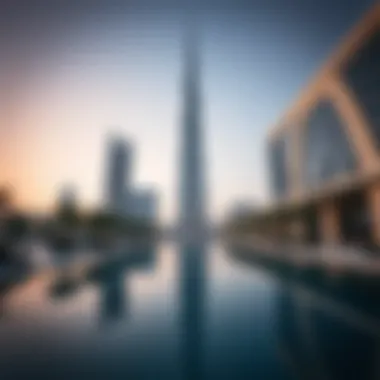
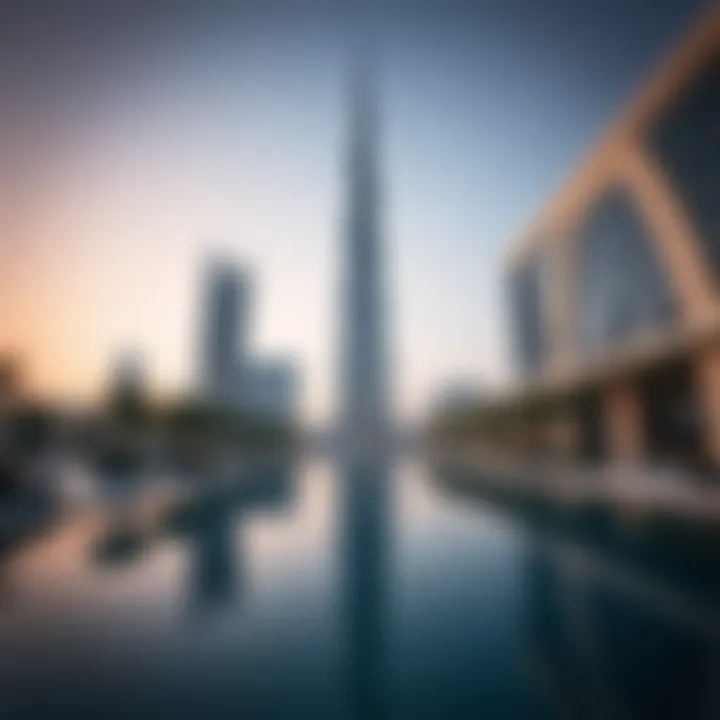
Additionally, the building showcases a distinctive minaret-like structure that not only serves as a visual marker of the skyline but also symbolizes the importance of community and spirituality in Dubai's culture. The harmonious proportions and symmetry found throughout the design create a sense of balance and presence, establishing a welcoming feel.
Construction Timeline
The construction timeline of Dubai's first building serves as a vital chapter in its history, marking key moments that contributed to the city’s architectural legacy. It is not just a sequence of events, but a narrative woven into the very fabric of Dubai's identity. Understanding this timeline helps illuminate how historical circumstances, technological advancements, and architect vision coalesced to give birth to a defining structure.
Initial Planning Stages
In the early days, the vision for the first building was born out of necessity. Planners and architects grappled with incorporating cultural elements into a modern design. The discussions were not merely about aesthetics; they were also a reflection of the communal aspirations for a burgeoning metropolis.
Efforts began with a sketch or two, which later transformed into detailed blueprints. Exchange of ideas was commonplace, often involving local historians to knit traditional styles into contemporary frameworks. The initial planning stages also faced challenges, particularly in forecasting growth and sustainability. Investors, many of them local traders or newcomers drawn to Dubai's opportunities, saw potential in this endeavor. They were not just putting money into bricks and mortar; they were investing in a vision.
Challenges Faced During Construction
As is often the case with ambitious projects, the construction phase was fraught with hurdles. The desert environment posed multiple challenges, from the heat to the scarcity of resources. Workers had to be strategic, sometimes laboring in shifts during cooler parts of the day. Moreover, sourcing materials presented its own set of complications; many local suppliers were not yet equipped to deliver on a large scale.
Another layer of complexity arose from the political atmosphere of the time. There were ongoing discussions about land use, regulations, and community standards that delayed progress. Communication barriers due to diverse labor forces from different regions also impeded the workflow. Despite these obstacles, innovative solutions were employed, including collaborating with skilled artisans from neighboring regions and carefully navigating governmental policies.
Completion and Inauguration
Eventually, planning and perseverance paid off as the building took its final shape. With its completion, a festival-like atmosphere set in. The inauguration was more than just a ceremony; it was a cultural celebration that underlined this building's significance to Dubai. Local leaders emphasized its role in setting the groundwork for further development in the region.
Visitors, community members, and dignitaries flooded in to witness the historical moment. The media coverage was extensive, capturing the pride of a community that watched a dream become reality. This landmark marked not just the completion of a structure but also symbolized the ideals of modernity blended with tradition, laying the groundwork for Dubai's rapid transformation into a global hub.
The construction timeline of Dubai's first building encapsulates not just a sequence of events, but a transformative journey that shaped the city's future.
Understanding this timeline enables investors, architects, and urban planners to appreciate the significance of historical context in modern architectural endeavors. It acts as a reminder of how perseverance can turn ambitious visions into reality, setting precedence for future developments in the area.
Cultural Significance
The cultural significance of Dubai's first building transcends mere bricks and mortar; it serves as a living testament to the city's rapid transformation from a modest fishing village into a bustling metropolis. This structure stands not only as a piece of architecture but as a symbol of aspiration, ambition, and resilience. Its importance is multilayered, reflecting economic growth and social changes that have rippled through the city over decades.
Symbol of Progress
The first building in Dubai is frequently referred to as a symbol of progress. When it was constructed, this landmark represented an era where the local population began to envision a future that was once thought to be only possible in dreams. The building's architecture mirrors the challenges faced during its inception, with each stone laid reflecting the tenacity with which early residents pursued modernization.
- Economic Driver: The completion of the first building catalyzed the economic landscape, drawing in investors and to create commercial opportunities that encouraged further developments. With increased commerce, the building has become a pivotal point, leading to economic prosperity, including growth in tourism and local businesses.
- Civic Identity: This architectural gem has progressively carved out a distinct identity for Dubai. It reflects the unique cultural blend of tradition and modernity—a hallmark of the city. As visitors and locals alike admire its striking features, they are reminded of the journey of their city and its people while shaping their civic pride.
Tourism and Heritage
Another critical aspect of cultural significance lies in its dual role as a tourism magnet and a repository of heritage. Today's tourists flock to see the first building, providing a link to Dubai’s roots amid the forward-looking developments that dominate the skyline.
- Visitor Experience: The first building offers an authentic glimpse into Dubai's past, showcasing traditional architecture alongside narratives that highlight its history. Tourists are often enthralled not only by the structure itself but also by guided tours that provide insights into the lives of people who once inhabited the area.
- Cultural Programs: Preservation efforts have led to the creation of cultural programs aimed at educating both citizens and visitors. Workshops, performances, and historical exhibitions held here bring the heritage to life, allowing the interchange of ideas and intercultural dialogue.
"Preserving the past amidst present glory is not just an act of nostalgia; it’s a way of preparing the foundation for future growth."
Thus, this building holds tremendous cultural weight, serving as a bridge between the ancient and the modern, and playing a pivotal role in enhancing Dubai's international standing as a cultural hub. By recognizing and fostering this heritage, Dubai has positioned itself as both a guardian of its history and a pioneer in architectural innovation.
Impact on Real Estate Trends
The importance of the first building in Dubai's skyline cannot be overstated. Its influence ripples through the realms of architecture and economics, shaping not just physical spaces but also the ethos of urban living. As investors, agents, and property managers navigate the dynamic landscape of Dubai, understanding the impacts that this historical structure initiated is essential for making informed decisions. This section dives into how this early architectural endeavor acted as a catalyst for urban expansion, influenced modern developments, and ushered in lucrative investment opportunities.
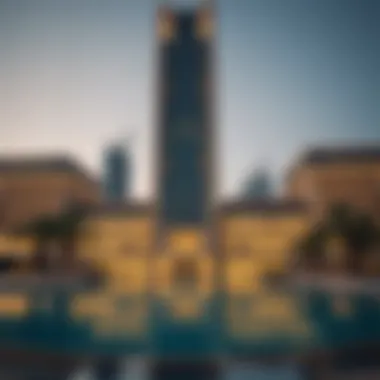
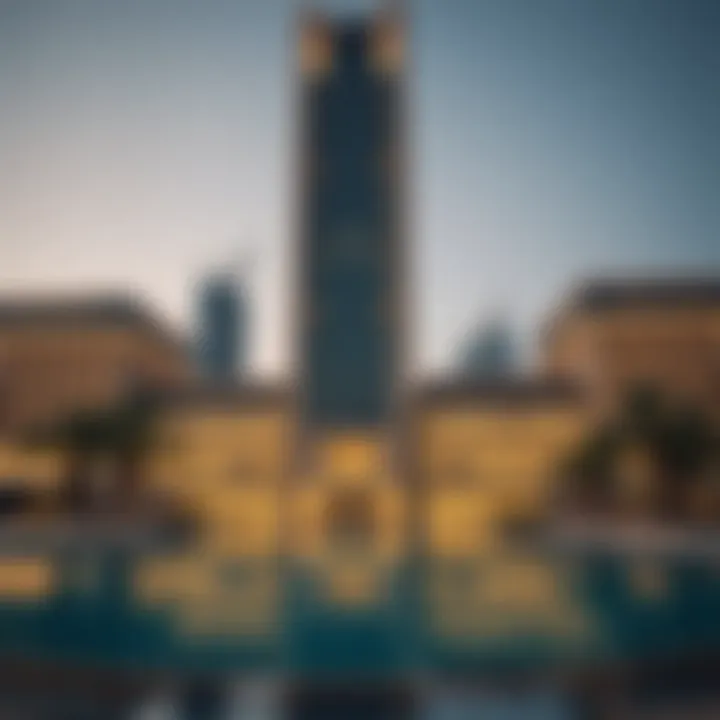
Catalyst for Urban Expansion
The first building in Dubai was not just a concrete structure; it truly served as a beacon that illuminated the path to the city’s rapid urbanization. Before its establishment, Dubai was largely seen as a modest coastal town. The presence of this defining edifice marked the beginning of an era where the city turned its gaze towards modernization and growth.
"Urban expansion in Dubai was ignited by the unique architectural statements that characterized its growing skyline."
The striking design of the first building acted as a magnet, drawing in commerce and tourism. As businesses began to cluster around it, the area transformed into a bustling hub of activity. Areas adjacent to the building witnessed the sprouting of shops, cafes, and offices, contributing to a domino effect of urban development. This initial push fueled infrastructural improvements, from roads to water supply, further enabling expansion.
Influence on Modern Developments
Today's skyscrapers stand tall around the original structure, but the influence of that first building is palpable throughout. It set a precedent for architectural innovation that modern developers eagerly embraced, blending traditional styles with contemporary aspirations. The ambition to build taller and more intricately designed structures became the hallmark of Dubai’s identity.
Real estate developers now often reference the first building in their proposals, invoking its historical significance to reassure investors that they are investing in a locale with rich heritage and potential. This relationship between the first architectural element and subsequent projects reveals an ongoing dialogue that shapes modern developments in Dubai.
Some notable influences include:
- Design Language: The motifs and colors used in newer constructions often echo the aesthetics introduced by the first building, creating a coherent cityscape.
- Urban Planning Principles: Modern factors such as mixed-use developments sprung from the early insights gained from the viability of the first building’s location.
Investment Opportunities Derived
Real estate is intrinsically tied to the allure of historic significance for many investors. The first building’s legacy opens up avenues for development that catch the eye of buyers and renters alike. Potential investors recognize that properties in proximity to such an iconic structure are heavily favored due to perceived value. This results in a flourishing market area, driving up demand and prices.
Investment opportunities emerge in various forms:
- Residential Developments: The zoning regulations around the initial building have encouraged high-rise apartments that attract expatriates and locals looking for premium living spaces.
- Commercial Ventures: Businesses eager to capture the tourist and local traffic flock towards properties near the original structure, fueling retail expansion and increasing footfall in the area.
- Cultural Projects: Opportunities exist for museums or galleries that celebrate the rich heritage surrounding the first building, bringing in sponsorships and partnerships that can financially benefit investors.
Understanding these dynamics allows property managers and agents to anticipate trends and shape their strategies. The historical relevance of the first building in Dubai’s real estate scene is not merely nostalgic; it serves as an essential guide for future investments.
Current Status of the Building
The current status of Dubai's first building provides a crucial lens through which to view its impact on the city's architectural landscape today. Anchored in history yet firmly integrated into the urban fabric of modern Dubai, this building stands not merely as a remnant of the past, but as a key player in the ongoing narrative of urban development and heritage conservation. Its well-maintained structure showcases a commitment to preserving Dubai's architectural roots while also accommodating the changes that come with progress.
Restoration and Preservation Efforts
Restoration efforts for the building are not just about keeping bricks and mortar intact; they embody a philosophy of honoring and preserving the legacy that shaped Dubai's journey. Significant initiatives have been launched to make sure that the building remains structurally sound while also reflecting its historical authenticity.
One of the standout aspects of these efforts includes:
- Material Authenticity: Only original materials or as close to the original as possible are used in restoration, preserving the building’s authentic look and feel.
- Architectural Integrity: The restoration process retains the unique architectural elements that define the building's character, including specific design features that might be overlooked.
- Sustainability Practices: Incorporating modern sustainable techniques into restoration not only saves resources but also resonates with contemporary architectural principles.
It’s worth noting that these efforts have garnered attention from local and international heritage bodies, aligning with global standards of architectural preservation. The restoration transforms the building into a bridge connecting Dubai’s past with its ambitious future, keeping it relevant amidst the towering skyscrapers populating the skyline.
Public Access and Viewing
Public access to this iconic building plays a vital role in its status as a cherished landmark. Open to visitors, this building serves as both an educational tool and a tourist attraction, giving people a direct connection to Dubai’s roots. Guided tours are organized, allowing guests to delve into detailed narratives of the building’s history and significance. The experience is enhanced by:
- Interactive Exhibits: Utilize advanced technology to provide engaging narratives that highlight the evolution of the architecture and its cultural significance.
- Viewing Platforms: Designed to allow visitors to admire not just the building but also the stunning surrounding vistas of the city, creating a perpetual engagement of past with the present.
- Community Events: Regularly scheduled events foster community involvement, from art exhibits to cultural festivals, encouraging local participation in the building’s ongoing story.
"Preserving our architectural heritage is about celebrating stories that will resonate for generations."
In summary, the current status of Dubai's first building is more than a snapshot of brick and mortar; it’s a dynamic representation of a cultural legacy. As restoration efforts continue and public engagement expands, this building finds itself as both a historical beacon and a participant in the vibrant urban narrative that is modern Dubai.
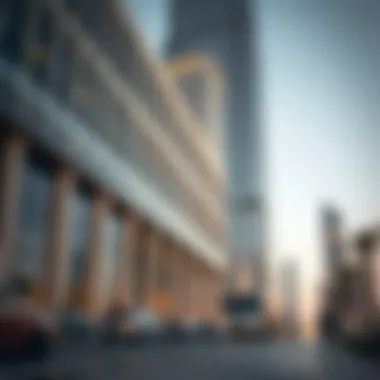
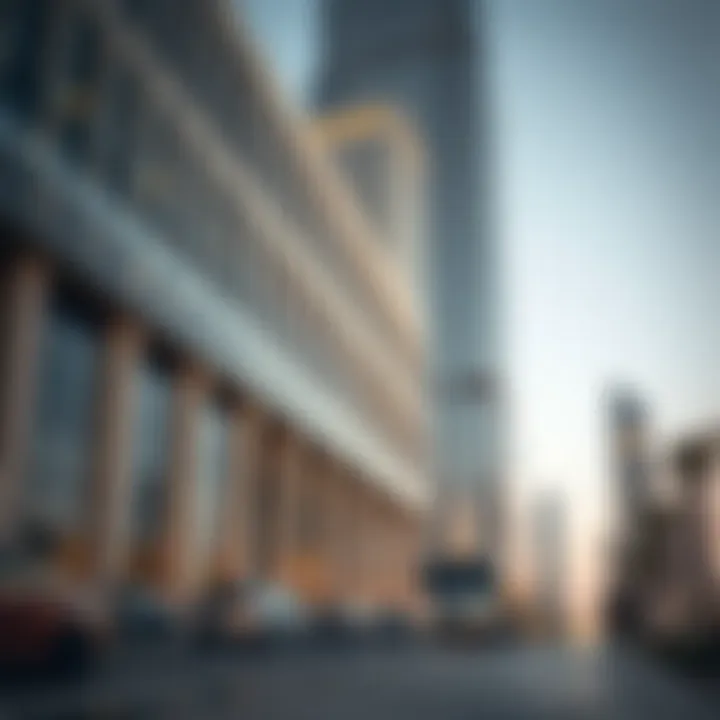
Future Prospects of the Property
The future prospects of Dubai's first building present a multifaceted canvas full of opportunities and challenges. By delving into its integration within urban planning and potential economic impact, one can surmise that this historical site possesses a treasure trove of potential that could benefit both the local economy and the broader community.
Integration in Urban Planning
When we talk about integrating Dubai's first building into contemporary urban planning, we're examining a practice that embraces both heritage and modernity. This building is more than a mere relic; it's a bridge connecting Dubai's historical fabric to its ambitious future. As the city continues to expand and evolve, incorporating this structure into the greater urban tapestry can offer a range of benefits:
- Cultural Landmark: Positioning the building as a cultural hub can elevate its significance in urban planning. It could host art exhibitions, local markets, or community events, breathing life into history while promoting engagement.
- Smart City Initiatives: In an age where technology drives urban development, integrating smart technologies into the building’s restoration and management can enhance visitor experience and operational efficiency.
- Sustainable Development: As Dubai leans toward sustainability, there’s an opportunity to showcase eco-friendly restoration methods. Implementing green technologies could set a precedent for historic buildings in the region.
The blending of historical preservation methods with modern urban requirements could inspire other cities grappling with similar issues of maintaining cultural identity while pursuing growth.
Potential for Economic Impact
Understanding the potential economic ramifications of revitalizing Dubai's first building is crucial for investors, property managers, and city planners alike. With strategic investments and commercial foresight, the building could serve as a formidable asset:
- Tourism Revenue: As it stands, Dubai attracts millions of tourists each year. By highlighting the significance of this building, it could becoming a must-see destination, thereby generating additional revenue streams for the surrounding area. This could indirectly foster new businesses and job opportunities in hospitality and retail.
- Rental Income: Should the building be converted into a mixed-use property—combining commercial spaces with cultural aspects—it could yield consistent rental income. Think cafes, art galleries, or boutique shops that align with its historic charm.
- Real Estate Valuation: Renovating and restoring such a landmark could increase the surrounding real estate values. Having a historical building can make nearby properties more desirable, attracting buyers and investors who value both charm and functionality.
"Historic buildings are not just remnants of the past, they are catalysts for future growth."
Lessons Learned from the Building's History
The examination of Dubai's first building provides a rich tapestry of insights to glean from the past. As we peel back the layers of its history, it becomes apparent that not only does this edifice stand as a monument of architectural prowess, but it also serves as a case study in sustainable development and community engagement. Analyzing the lessons learned from its historical trajectory offers invaluable perspectives for today’s architects, developers, and policymakers.
Architectural Heritage Considerations
Dubai's first building is more than just bricks and mortar; it’s a testament to the area’s unique architectural heritage. Preservation of these heritage structures proves crucial for fostering a sense of identity among the residents. The lessons are clear: any future construction must respect the elements that define the city’s historical character while integrating modern advancements. Here are some key considerations based on this building’s heritage:
- Blend Old and New: Future projects should adhere to principles that harmonize traditional materials like coral stone and palm fronds with modern ones such as steel and glass.
- Respect Cultural Narratives: Every alteration or renovation should encapsulate the cultural narratives that the original structure portrays, ensuring continuity in the collective memory of the community.
- Economic Viability: Maintaining the building’s historical integrity can also be economically viable. Placing heritage sites at the core of urban planning can attract tourism, bolstering local economies.
The architectural heritage of such a pivotal building reminds us that modern developments do not have to come at the expense of historical value. Attempts to create a sense of place can be achieved through thoughtful revitalization that resonates with locals and visitors alike.
Community Engagement in Urban Development
The story of this first building is as much about its physical structure as it is about the communities that surrounded it. Engaging local input during its planning and development phases allowed for a more inclusive process, affecting the building’s success and relevance. Here are some takeaways about community engagement:
- Inclusive Planning: Encouraging residents to voice their perspectives fosters a sense of ownership. When the community is involved, it becomes more likely that the development will meet their needs.
- Adaptive Use: The building’s ability to serve multiple functions in the community can be a lesson for current projects. Whether it is a public space, gallery, or meeting center, multipurpose buildings can enhance social cohesion.
- Cultivating Local Talent: Engaging local workers in the construction and maintenance of such buildings can be beneficial. This approach serves not only to utilize skills found within the community but also to instill pride.
"The integration of community voices in urban planning not only cultivates trust but also nurtures a sustainable environment for future generations."
For further insights into urban development strategies, refer to resources from UNESCO on heritage preservation, or explore articles from Harvard University discussing community engagement practices.
Closure
In summarizing the significance of Dubai's first building, we draw attention to a key artifact that represents the start of the city’s architectural evolution and urban metamorphosis. This building isn't just a structure; it embodies the spirit of a community and the ambition of a nation. The journey of this building through the years reflects the broader narrative of Dubai's transformation from a modest trading post to a bustling metropolis renowned for its skyline.
Summary of Key Points
- The first building in Dubai marked a pivotal moment in the region's architectural journey, anchoring the city's cultural identity amidst rapid modernization.
- Design elements were heavily influenced by local traditions while accommodating the changing needs of a growing population.
- The construction faced numerous challenges, yet its completion signified resilience and innovation, traits that define Dubai today.
- As a cultural and historical landmark, it has become a symbol of progress that attracts both tourists and investors alike.
- The concerted efforts for its restoration highlight the importance of preserving architectural heritage in the face of rapid urban development.
The Lasting Legacy of Dubai's First Building
The enduring legacy of Dubai's first building goes beyond its initial purpose; it serves as a touchstone in the city's ongoing story. Reflecting the architectural heritage, it emphasizes the essential balance between tradition and modernity.
As highlighted by various sources, the preservation of such landmarks is crucial for nurturing community identity and fostering urban cohesion Wikipedia, Britannica.
Investors and property managers often witness firsthand how historical significance can enhance real estate value. The building’s presence continues to attract considerable interest, echoing the lessons learned throughout its existence. Its story reminds all of us that while we build for the future, we must not discard the foundations laid by our past.



